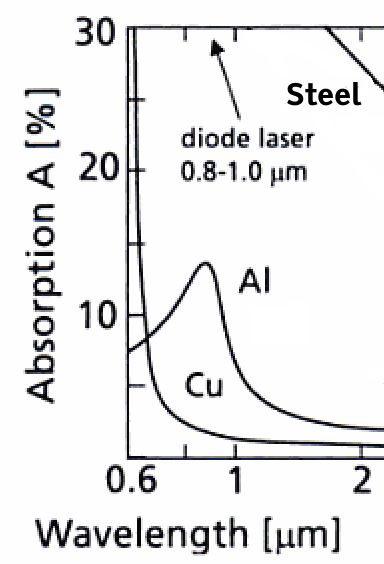|
⇤ ← Revision 1 as of 2013-01-15 21:15:32
Size: 1113
Comment:
|
Size: 1176
Comment:
|
| Deletions are marked like this. | Additions are marked like this. |
| Line 5: | Line 5: |
| Rocket upper stage tanks have a thickness from 1 to 5 mm (Need Reference) and are typically aluminum alloy. Aluminum has an absorption peak of 14% around 900nm (1) | Rocket upper stage tanks have a thickness from 1 to 5 mm (Need Reference) and are typically aluminum alloy. Aluminum has an absorption peak of 14% around 900nm (LOOSEN1998). |
| Line 22: | Line 22: |
| (1) Peter Loosen, ''Lasers in Materials Processing'', figure 6 on page 291 in [[ http://books.google.com/books?id=l3yk_yBPAuIC&pg=PA287&lpg=PA287&dq=Peter+Loosen+Lasers+in+Materials+Processing&source=bl&ots=hZKod4LG13&sig=BBarW-P1rDi8gz4GZxtVIjHnp6o&hl=en&sa=X&ei=0ML1UPiqHuXoiALAxIGwBQ&ved=0CDMQ6AEwAA#v=onepage&q=Peter%20Loosen%20Lasers%20in%20Materials%20Processing&f=false | ''Advances in Lasers and Applications'' 1998. ]] |
||(LOOSEN1998) Peter Loosen, ''Lasers in Materials Processing'', figure 6 on page 291 in [[ http://books.google.com/books?id=l3yk_yBPAuIC&pg=PA287&lpg=PA287&dq=Peter+Loosen+Lasers+in+Materials+Processing&source=bl&ots=hZKod4LG13&sig=BBarW-P1rDi8gz4GZxtVIjHnp6o&hl=en&sa=X&ei=0ML1UPiqHuXoiALAxIGwBQ&ved=0CDMQ6AEwAA#v=onepageq=Peter%20Loosen%20Lasers%20in%20Materials%20Processing&f=false | ''Advances in Lasers and Applications'' 1998. ]]||{{attachment:laserAlum.png| |height=200}}|| |
Making Ballast from Rocket Tanks with Lasers
Space debris may be an opportunity, not a problem. Rocket tanks may be cut into gram-sized weights with lasers, then added to ultra-thinsats to stabilize their orbits against light pressure. Perhaps, with some technological advances, we can learn to build solid state lasers that don't need optics, and mount them on thinsats. A 100 milliwatt (average) pulsed laser will not cut metal very fast, but in time it will cut it.
Rocket upper stage tanks have a thickness from 1 to 5 mm (Need Reference) and are typically aluminum alloy. Aluminum has an absorption peak of 14% around 900nm (LOOSEN1998).
(LOOSEN1998) Peter Loosen, Lasers in Materials Processing, figure 6 on page 291 in ''Advances in Lasers and Applications'' 1998. |
|

